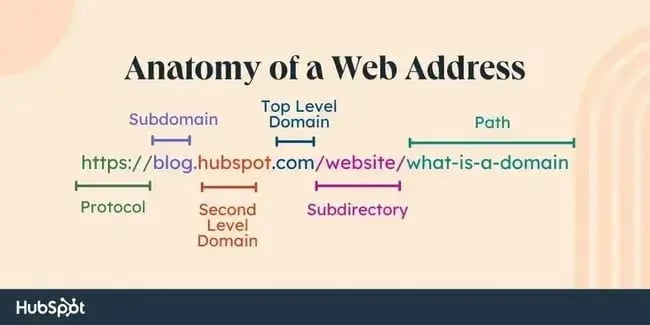A domain name is your brand’s online identity, location, and presence. Instead of typing a long string of numbers for the IP address, a domain gives you an easy-to-remember online name that people can type, share, and trust.
In this article, I’m sharing my experiences, lessons, and insights on learning, choosing, and registering domains. I’ll also share why domains matter so much and how the right one can impact your branding, marketing, and online identity.
Table of Contents
- What is a domain?
- What does a domain look like?
- What is a domain name?
- Parts of a Domain Name
- What is a domain name example?
- Domain Name vs. URL
- Internet Domain vs. Network Domain
- What are domains used for?
- Types of Domains
- Who manages domain names?
- Setting Up Your Domain
- How to Pick a Punchy Domain Your Visitors Won’t Forget
What is a domain?
A domain is the string of characters a user types into their browser to find your website. It translates a website's numerical IP address into an easy-to-remember format.
For example, the IP address for HubSpot.com is 172.64.148.142.
An IP address is a string of numbers that identifies the website server. However, remembering the numerics for each website would be impractical. So, we use the domain names instead of the IP address. Domains make your online existence memorable and accessible.
Once you register a domain address, the Domain Name System (DNS) maps the text address to your website‘s hosting server’s numeric IP. DNS converts your domain names into IP addresses.
In my first year of computer engineering, a teacher explained it simply. My teacher opened his phone contacts and said, "I have around 300 numbers saved here. I don't remember any of them, but I can still call people using their names, just like using domain names instead of IP addresses.”
The same goes for visiting a website. Instead of memorizing a website’s IP address, visitors type in the domain into their browser.
What does a domain look like?
A domain typically consists of two or three words separated by periods. A simple example of a domain is hubspot.com.
What is a domain name?
A “domain name” is the same thing as a “domain,” which is the same thing as an “internet domain” or “web domain.” These terms are used interchangeably.
The maximum length of a domain name, not including its extension (like “.com”), is 63 characters. The minimum length is one character. For a quick overview of what a domain name is and what it's made of, check out this video by Elegant Themes.
Parts of a Domain Name
A domain typically has two parts: the second-level and the top-level. Some domains also have a third-level label.
Second-Level Domain (SLD)
Hubspot comes before the .com in the domain for Hubspot.com. Here, Hubspot is the SLD. It primarily identifies the name of your website. The other part, or TLD, is just a system requirement.
When buying a domain, I always try to make the SLD short and memorable so it’s easy for people to find it. Relevance is the key. The more memorable the SLD, the better the domain will serve its purpose.
Before buying a domain, I say the name out loud a few times to gauge its flow. I also share the name with my wife, and if she repeats it back correctly, the SLD passes!
Famous people stumble on domain names too. Even the iconic rock band Linkin Park ran into this problem, and it led them to change their name.
They originally called themselves Lincoln Park, but the domain lincolnpark.com was already taken. So, to grab an available domain, they tweaked the spelling to Linkin Park and registered the domain linkinpark.com.
Top-Level Domain (TLD)
The top-level domain is the extension or the part of your domain that indicates the type of entity you are. For example, HubSpot’s top-level domain is “.com” since we’re a commercial entity in the United States.
Most American businesses register their website with “.com.” In fact, according to data from Verisign, the largest TLD in 2024 was .com, with 156.3 million reported domain names in the domain name base.
Other TLDs include “.edu” for accredited post-secondary educational institutions, “.gov” for government, and “.org,” which is usually for nonprofits.
Some domains also have additional levels, as in google.co.uk, where “.uk” is the TLD, “co” is the SLD, and “google” is a third-level label. Together, these parts form the full domain name that users type to visit a site. With the rise of AI, a new type of TLD, “.ai,” is emerging, and most AI-related websites are using it.
What is a domain name example?
An example of a domain name is usps.com. This is made up of a second-level domain (“usps”) and a top-level domain (".com”).
Other examples of popular domain names include:
- youtube.com
- irs.gov
- harvard.edu
- redcross.org
Check out more in the image below:

These are just a few domain name examples — there are millions more. According to data from Verisign, there were over 368.4 million registered domain names at the end of Q1 2025.
Domain Name vs. URL
A URL (Uniform Resource Locator) is the complete web address for a specific page, and it includes your domain name plus other required information to visit your website.
Your domain is just one part of the URL. A URL, also called a web address, typically consists of a protocol, domain name, and path.
In other words, the domain is one component of the URL. Domain identifies the site, while the protocol/path specifies how to reach a particular page on that site.
For example, the URL of this blog post is https://blog.hubspot.com/service/what-is-a-domain. It's made up of the following parts:
- Protocol (“https://”)
- Domain name (“blog.hubspot.com”), that comes with a subdomain (“blog.”), a second-level domain (“hubspot”), and a top-level domain (“.com”)
- Subdirectory (“/service/”)
- Path (“/what-is-a-domain”)


Internet Domain vs. Network Domain
The word “domain” has a different meaning in networking. A network domain is an internal grouping of computers or devices within a private network.
An internet domain is what I've been discussing so far and refers to the address of a website on the public internet.
A network domain functions entirely differently. It describes a group of interconnected devices like desktops, printers, and servers sharing the same purpose. For instance, during my computer engineering days at the university, we used a network domain to manage all our lab computers and printers under a single administrative domain.
An administrator is usually in charge of managing the devices within this network. Users in a network domain can communicate with each other, but often have different access levels depending on their role and administrator permissions.
What are domains used for?
Domains are used to help visitors find your website, but they also serve a variety of other purposes. I'll go over some common reasons below.
1. Gaining Ownership
Although you can purchase a domain, it's not permanent like a property. You purchase it for a period, such as one year or five years. Then, you need to re-register it, paying yearly fees. Once you stop paying, you will lose your domain, and somebody else can have it.
So, I prefer using the word “Register.” No one else can claim it while you have it registered legally without any trademark infringement. Beyond that, if you have a registered business with a trademark, you can discourage bad actors from purchasing a similar brand name or domain.
If you have an important domain, put it on auto-renew to prevent it from expiring. You will receive an invoice and notifications, usually a month before the expiration date.
I forgot to renew my portfolio domain last year. So, it expired. My website was offline for two days. I got lucky as it wasn‘t a big business website, or that I don’t have a popular name. I may have missed it.
2. Solidifying Brand Identity
A domain name establishes a consistent online brand identity. While surfing on my website, a visitor may move from my website's homepage to my blog to my knowledge base, and will notice that the core domain name remains consistent. This reinforces other consistent elements, like the color scheme and typography.
3. Building a Custom Email Address
A custom email address with your business name builds trust with customers when you reach out.
If I use an unrelated email name, the receiver might get confused about whether to trust the message, even if I sent it. But, when I send the email from @hubspot.com, the recipient immediately recognizes it as coming from a legitimate business authority without any confusion.
HubSpot lets you connect your custom domain to your email. Inspire consumer trust and brand recognition by connecting your custom domain to your website for free.
4. Establishing Credibility
A custom domain that matches your company or product name makes your website look professional. That builds trust with visitors so they feel comfortable taking action.
For example, after a decade of writing, I have a website, zadhidpowell.com. That has more credibility than a free site from WordPress.
Pro tip: You can build a website (no coding skills required) using Content Hub and connect a custom domain for no extra charge.
5. Being Memorable
I don‘t memorize long domain names, and I can assume you don’t either. Keeping your site name punchy and aligned with your brand is good for business.
But what if your brand name is long? Say it's something like T-Bones Great American Eatery! Typing in t-bonesgreatamericaneatery.com would take ages. Meanwhile, the domain t-bones.com is easy, catchy, and short to type.
Your domain should be memorable so that it's easy for visitors to quickly enter it into their search bars, resulting in more direct traffic to your site.
Pro tip: You can get to Facebook.com by just typing Fb.com in the address bar. It's also a subdomain Facebook uses for easy entrance.
6. Standing Out Against Competitors
A simple but catchy domain name distinguishes your site from competitors with clunkier or confusing domains.
Google initially started with the domain BackRub! Now imagine having to BackRub every time you need some information or asking someone to BackRub it for you. Even thinking about it feels awkward.
It's unlikely that Google would have become as popular as it is today with that name, let alone compete with Yahoo and other search engines. Google is super catchy to hear, easy to remember, and has a visual appeal that grabs attention. The same goes for Amazon, eBay, and Apple.
7. Building Authority
Older domains often have an advantage in SEO. Search engines view longevity as a sign of credibility since older sites usually have built up content and backlinks. As a rule of thumb, the older a domain is, the more authority it has, which helps it rank better in the SERPs.
All the more reason to register a domain name sooner rather than later. If the name you want is used by an outdated, abandoned site, you can check the Expired Domains website for updates when it expires. I recently acquired a 17-year-old expired domain for just $15.
Types of Domains
1. Generic Top-Level Domains (gTLD)
gTLD refers to the best-known and most broadly used TLDs:
- .com
- .net
- .co
- .io
- .biz
- .org
- .info
- .ai
Today, “.com” is the most popular by far. As of August 2024, 44% of global websites used a .com top-level domain. The next most popular (“.org”) is used by only 4.2%.
2. Country Code Top-Level Domains (ccTLD)
These two-letter TLDs refer to specific geographical locations. Here are the most common ones:
- .cn (China)
- .ru (Russia)
- .de (Germany)
- .br (Brazil)
- .au (Australia)
- .uk (United Kingdom)
- .nl (Netherlands)
I had to test an Australian service website for my elder brother. So, I created some core content of his carpeting business (Sydney area) on a .com.au domain rather than a regular .com domain. The local ccTLD and IP location nudged the website pages into Aussie SERPs almost overnight without any paid ads.
3. Internationalized Country Code Top-Level Domains (IDN ccTLD)
These are domains that can be displayed in non-Latin character sets (e.g., Chinese). These domains are helpful for countries that use character-based languages.
4. Subdomain
A subdomain is part of a larger domain, appearing before the root domain name (e.g., blog.hubspot.com). Since a subdomain appears to the left of the SLD, it is also referred to as a third-level domain (3LD).
From my experience, launching landing pages on subdomains is smarter than launching on new domains. It keeps brand equity concentrated on the root domain without taking it to another branch.
Pro tip: With Content Hub, you can add your custom domain to HubSpot for free. This allows you to connect your new domain to hosting, CDN, and security features all at one time.
Who manages domain names?
As a computer engineer, one of the common questions I face a lot is, “Who owns the internet?” Nobody owns the internet — but in a way, we all do.
Different organizations and individuals own various parts and components of the internet. Each group has its role to keep things running smoothly. Their combined effort keeps the internet alive.
At the top, the Internet Assigned Numbers Authority (IANA) and ICANN (Internet Corporation for Assigned Names and Numbers) coordinate the global DNS and authorize registries and registrars. ICANN oversees the root zones and TLD policies to ensure the system runs smoothly.
ICANN makes sure that every domain name is unique and properly linked to its IP address. Regional organizations, called RIRs (Regional Internet Registries), also help manage the process in their own areas. For example, ARIN (North America) and APNIC (Asia Pacific) follow a set of policies to keep the DNS running properly.
In the middle, Domain Registries operate individual TLDs. For example, Verisign runs the .com registry, while other organizations run country TLDs. They maintain the database of all registered names under that TLD.
At the bottom, Domain Registrars are companies like GoDaddy, Namecheap, Google Domains, and many others. They have contracts with registries to sell domain names to the public. When you register a domain, you do it through a registrar, which records it with the appropriate registry.
These domains are expensive, start at $80, and you have to register them for at least two years. So, I wanted to use reliable registrars. I use Namecheap, Hostinger, and Crazy Domains to manage 27 of my domains. I have 10 domains in Hostinger. For my .ai domains, I suggest Namecheap because it's secure and reliable.
Setting Up Your Domain
If you already have a domain, you can connect it with a hosting provider and create a website. But if you don't have one, you have to buy one.
One easy way to do this is to connect your domain to your website with HubSpot. It‘s free. I’ll walk you through how to do it:
Step 1: If you haven’t yet, purchase a domain.
HubSpot isn’t a domain registrar, but it does provide web hosting and a drag-and-drop website builder so that anyone can have a professional website.
You can purchase a custom domain by clicking “Buy a domain” in your free HubSpot account. This part is powered by GoDaddy.


Type in your desired domain. If it’s already taken, GoDaddy conveniently recommends some alternatives.

It's a good idea to keep your domain registrar separate from your web host. I purchased my domain from Namecheap and use Hostinger for hosting, although I also have other domains with Hostinger.
It's just about my personal preference. As a computer engineer, I know the problems that arise online. So, I want to keep my online infrastructure diverse, just like the internet itself.
Step 2: Update DNS records.
Your DNS records are with your domain registrar. So, wherever you buy your domain (e.g., GoDaddy), log into that account and find the DNS records. HubSpot has easy-to-follow documentation on how to do this.
Step 3: Wait for DNS records to propagate.
After you’ve followed the steps in HubSpot’s documentation, sit back and relax! It could take up to 24 hours for the records to propagate. If there are any errors, the HubSpot dashboard will let you know.


How to Pick a Punchy Domain Your Visitors Won’t Forget
After buying over 50 domains, I‘ve learned that the best domains are short, bold, and stick in people’s minds. If you have to explain the domain twice or spell it out, it's probably not the one.
I've created a quick checklist based on my experience that you can use while buying a domain. You can also dive deeper into choosing a domain name.
- Is it a .com? Is there a better-fit extension like .ai or .io?
- Is it short and simple?
- Is it easy to say out loud?
- Is it number- and hyphen-free?
- Is it memorable?
- Are similar domains secured? Should you get a .net, .co, or .io domain instead?
- Is it available right now?
- Is it trademark-free?
Domains make all the difference.
Excellent domain names don't wait around. Organizations, businesses, and users are buying them all the time. Just a month ago, I lost a domain because I hesitated for 13 hours. If you have a great domain name in mind, be sure to register and connect your custom domain to your website. Soon, you’ll be online for everyone to find.
Editor's note: This post was originally published in February 2019 and has been updated for comprehensiveness
Web Hosting





.jpg)
.webp)







